I carry several cameras and lenses with me for good reason.
I have Chukar photos that I like better than these (partly because this bird never did give me anything but a rear view) but I thought the images and the situation allowed an effective demonstration of one of the reasons I carry a lot of camera gear in my pickup.
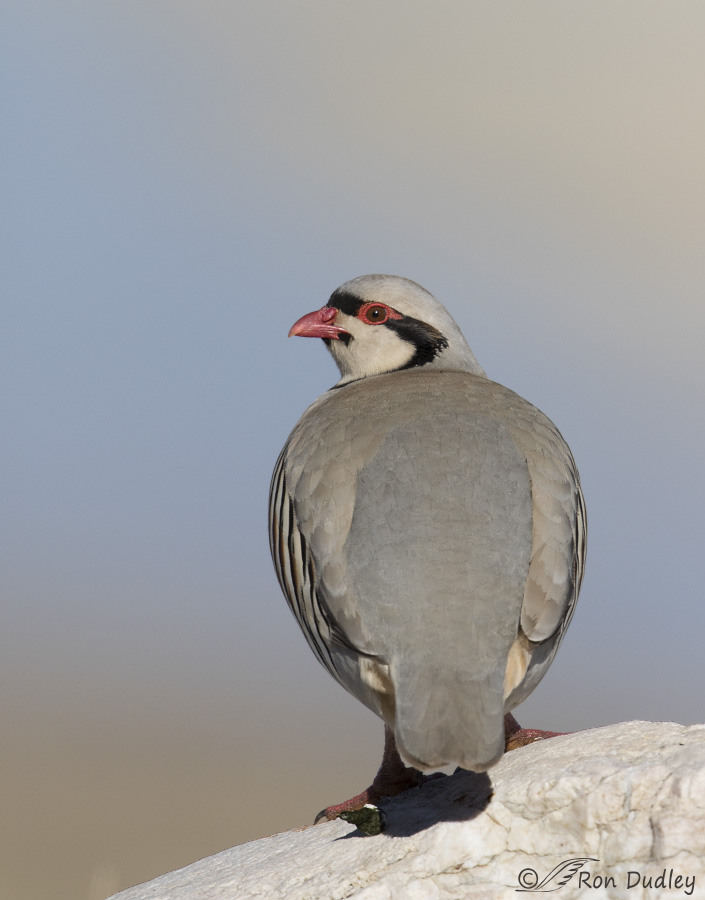
1/5000, f/6.3, ISO 500, Canon 7D Mark II, Canon EF 500mm f/4L IS II USM + 1.4 tc, not baited, set up or called in
Shot at 700mm with my cropped sensor camera
Yesterday morning I found this Chukar on a steep, downward slope and very close to the road on Antelope Island. The terrain dictated that I get quite close to the bird before I could even see it – so close that I had to shoot vertically using my standard 500mm with attached tc and even then the Chukar was too tight in the frame. I also had too little depth of field to get the tail sharp, though I could have played with my settings to improve that situation. I certainly didn’t need this much shutter speed.
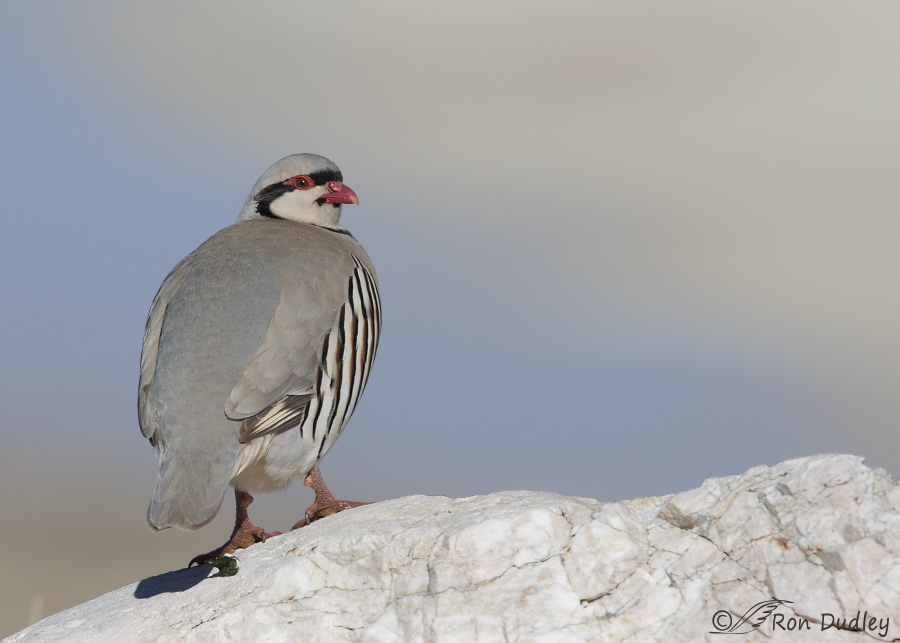
1/5000, f/7.1, ISO 500, Canon 7D Mark II, Canon EF 500mm f/4L IS II USM, not baited, set up or called in
Shot at 500mm with my cropped sensor camera
So I removed my teleconverter (tc) which allowed me enough room to frame the bird in a manner more pleasing to my eye.
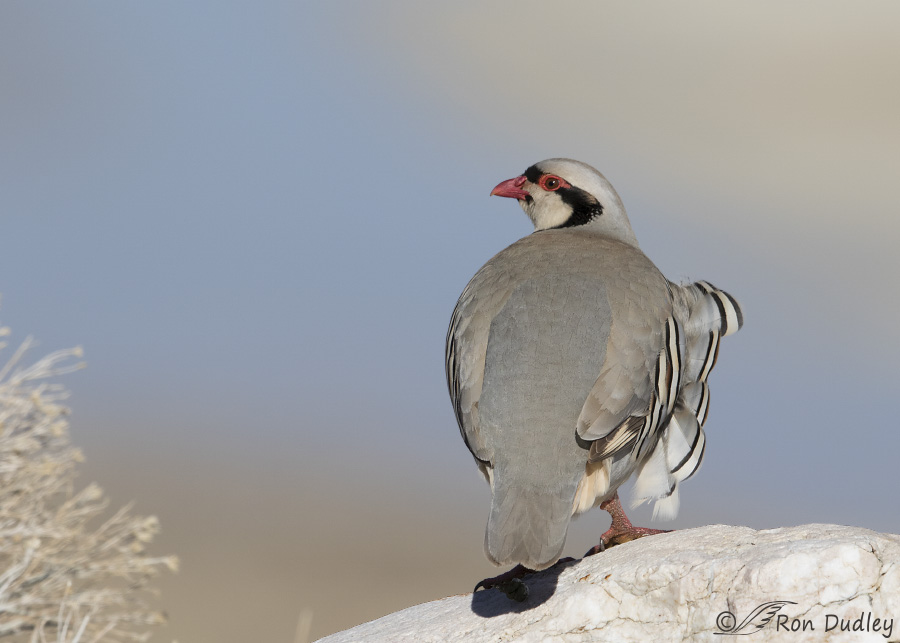
1/3200, f/7.1, ISO 500, Canon 7D Mark II, Canon EF 500mm f/4L IS II USM, not baited, set up or called in
Shot at 500mm with my cropped sensor camera
I’m including this image, shot at the same focal length as the previous photo, simply because I think the wind-blown feathers are interesting.
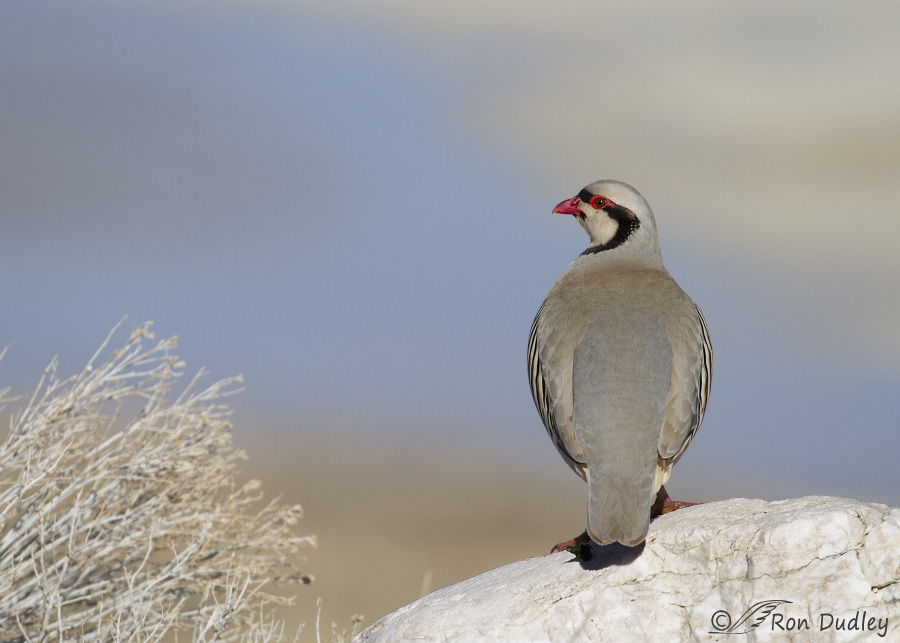
1/2500, f/6.3, ISO 400, Canon 7D, Canon EF 100-400mm f/4.5-5.6L IS II USM @ 400mm, not baited, set up or called in
Shot at 400mm with my cropped sensor camera
After taking lots of shots of the Chukar with its back to me I decided that my next goal would be to attempt to photograph the bird as it either flew off or scampered down the rock. If this happened my best chance to avoid clipping body parts was to allow even more room in the frame and this required switching to my zoom lens which I have attached to another camera.
However it also required cooperation from the bird, which I never got so I missed those shots.
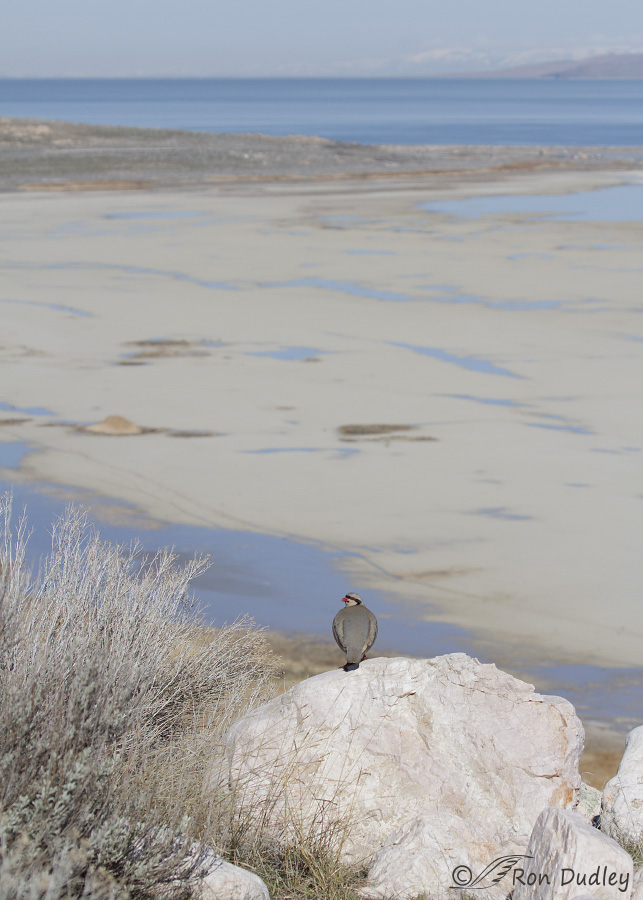
1/2500, f/6.3, ISO 400, Canon 7D, Canon EF 100-400mm f/4.5-5.6L IS II USM @ 100mm, not baited, set up or called in
Shot at 100mm with my cropped sensor camera
It was a beautiful morning on the island and I had plenty of time with the bird so as I often do I backed off with my zoom for a more expansive view. Even at only 100mm I had to shoot vertically to get both the bird and the horizon in frame. I wish I’d also grabbed my third camera with a standard lens attached and shot a few horizontals at about 50mm.
As you can see I was looking down on the Chukar with the mudflats of the Great Salt Lake below. In most years that area is covered with water but a variety of factors, including overuse of incoming river water by agriculture and industry, have drastically reduced the level of the lake to record lows.
I have a theory that the reason the Chukar never turned toward me was because it was enjoying the spectacular view.
I can’t blame the bird for that…
Ron
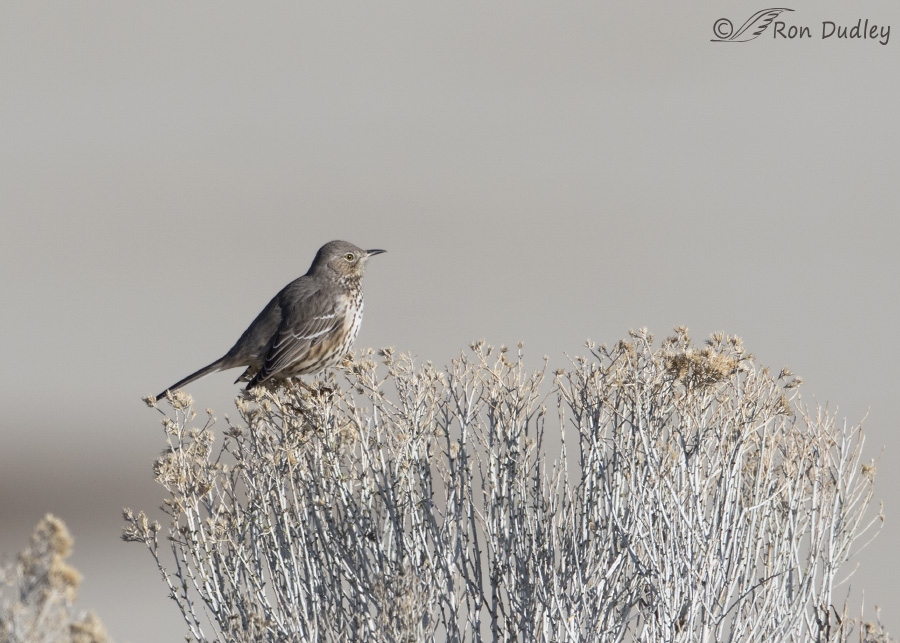 On another unrelated note, yesterday I saw my first Sage Thrashers of the year on the island – this is one of them. I never got close to any of them but I thought some local birders and photographers might be interested in their appearance. Spring is springing!
On another unrelated note, yesterday I saw my first Sage Thrashers of the year on the island – this is one of them. I never got close to any of them but I thought some local birders and photographers might be interested in their appearance. Spring is springing!


Beautiful shots Ron!
Charlotte
Good to see the examples, and you are lucky the bird sticks around long enough for you to capture images at different focal lengths. Would be fun to try .
Spring is springing indeed! Our dwarf peach tree is a shower of pink and white.
Another beautiful series Ron.
I know what you mean by the scampering across the rocks. I used to work in SE Oregon close to Farewell Bend on the Snake River.
When I was driving to the high ranch I used to try hunting Chukars. Never did succeed they were so quick. They seem to know just
when you were going to pull the trigger.
Just as well because they are beautiful
Sad to hear why wayer level of the Great Saly Lake is down…makes me wonder what’s happening these days to another amazing (threatened) body of wayer, Mono Lake…..
That “wayer” is, of course, supposed to be WATER , but evil iPad is at it again!!!
I am going to use Laura’s WOW, WOW AND WOW. And may in future just start every comment with WWW.
As I so often do.
Amazing view, and as you know I do have a weakness for the beagle boys. Thank you.
Thank you, EC.
Very very interesting and useful information Ron.
This is exactly what I needed to see the correspondence between uncropped images and the final result.
I have now an idea of what I can or can’t do with my gear.
Thank you very much.
I’m delighted that it was useful to you, Jorge.
How much wood would a Chukar chuck, if a Chukar could chuck wood? Would a Chuckar chuck all the wood that a Chukar could chuck….if a Chukar could chuck wood???
I “woodn’t” know, Patty…
What a beautiful series (yes, the ridiculously repetitively redundant OH WOW! goes here–LOL). I love Chukar for several reasons. They’re just beautiful, and again, we’ve gotta ask, “How do you do that plumage coloring thing?” Just beautiful!
What are the predictions for the water level to rise? Doesn’t look like you’re getting the rain in the southern plains. And abundant rain will only solve one of the list of issues, but still…
Laura, at this point there’s not much hope for the Great Salt Lake. Another project has recently been approved that will take even more water out of the Bear River before it reaches the lake. Stupidity!
WOW! That’s scary Ron. Hard to think of the west without the Great Salt Lake. Would they REALLY let it go? Shaking my head in disbelief.
A lot of locals don’t like the Great Salt Lake, Laura. It’s salty, mostly shallow and sometimes it smells. And it takes up a LOT of space. They don’t care about its uniqueness or its importance to migrating birds, they just want to be rid of it.
If that happens the northern part of the state would have a huge dust problem even in mild winds. But those ignoramuses are in denial. Sadly, there’s a lot of that going on these days…
Interesting shots…like the “Lord of the manor” last Chukar shot where the bird is appears to be surveying his birddom….must be nice to hear the thrasher’s song again….
Yup, it was, Patty. Didn’t hear much of it yet but I’m sure I will soon.
I couldn’t tell a difference between the prime and the zoom (and that’s something). You have certainly gotten your 1.4 TC dialed in tight for both configurations!! While I certainly appreciate the detail in your shots, I also appreciate the corresponding uncropped pictures as it provides perspective for how far away the subject is. This gives me an idea of the type of shots you are getting and what is achievable with your gear. And of course, I use that as a measuring stick for me, my gear and how close/far away my birds are and the IQ I’m getting (or not) with my pics. BTW…I joined CPS 2 days ago in no small measure due to the review you provided a few weeks back. My 500 and 1.4TC are en route to NJ now.
Zaphir, I should have made it clear in my text that each of these images has been cropped, slightly to moderately – none extremely (except for the thrasher).
Also, your comment pointed out an error I made in my techs. I didn’t use a tc for the shots taken with the zoom. I’ve corrected my error. Thank you for inadvertently bringing it to my attention.
I hope CPS does well by you. I think most folks are very pleased by their service from CPS but after that post you mention I did hear from one person who wasn’t happy with his CPS experience.
No doubt about it Ron, you are a “teacher,” and a great one at that. Seeing this series of images has reinforced in my mind an
idea I have (actually a request) that I will propose to you some night when I can’t sleep, and come here to my computer at 3:00am
to work on my own images… You are a constant, and continuing inspiration to all us birders, and photographer wannabees… ;-)))
Thanks, Roger. I guess teaching is ingrained in me but there’s sure a lot I still have to learn too. I’m far from an expert but I do like to throw stuff out there in case it’s helpful to some folks.
The Chukar certainly is beautiful – great shots! Don’t know if I’ve seen a Sage Thrasher or not – sure blends into the “woodwork”
“sure blends into the “woodwork”
They sure do, Judy. It’s a good thing that they like to perch high on conspicuous perches in the spring or I’d nearly always miss seeing them.
The Chukar is beautiful. And thanks for the Thrasher – I’ve seen many but never the Sage.
Thank you, Sallie. Sage Thrashers are a delight, especially when they’re displaying just prior to nesting.